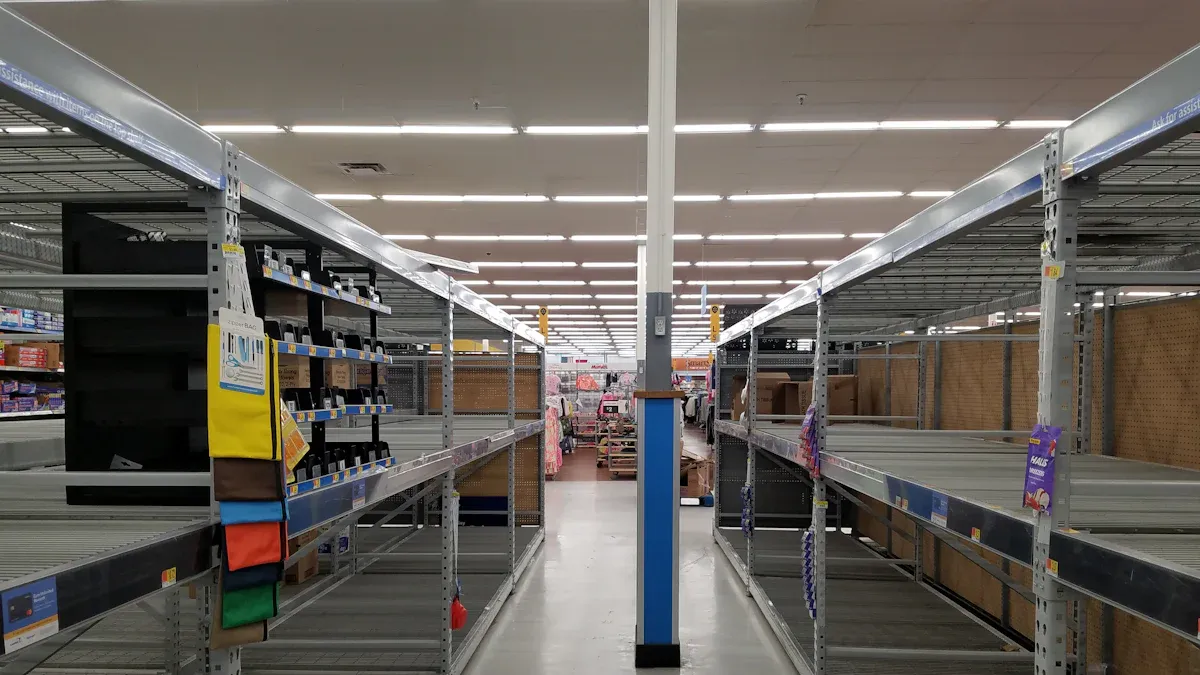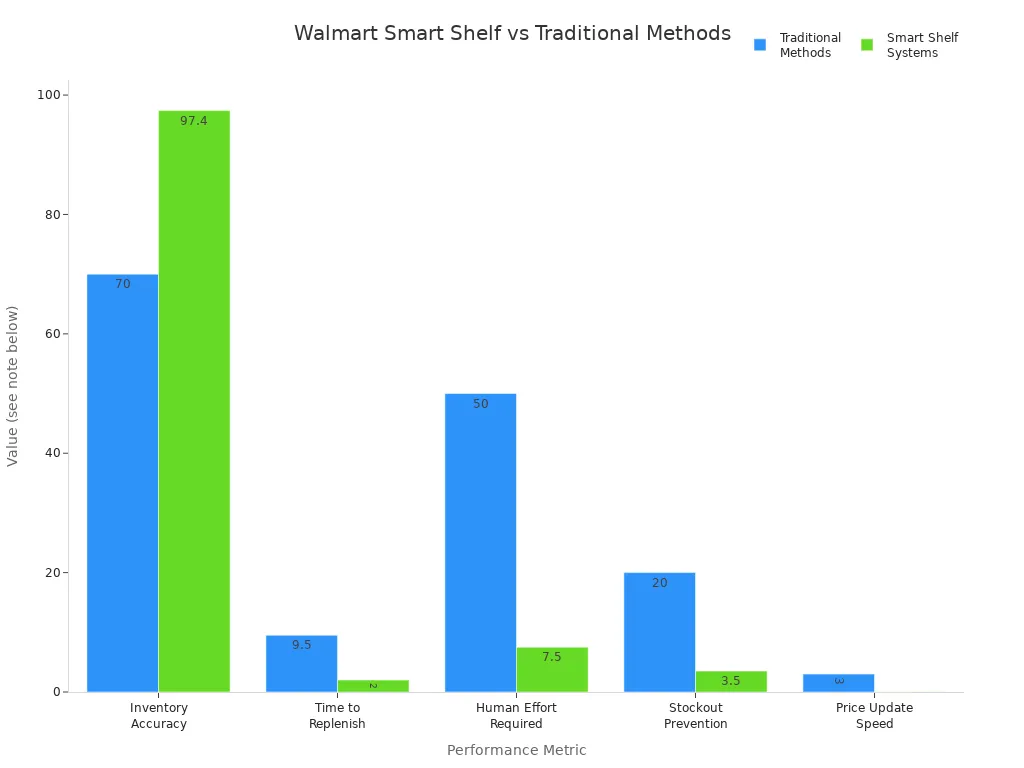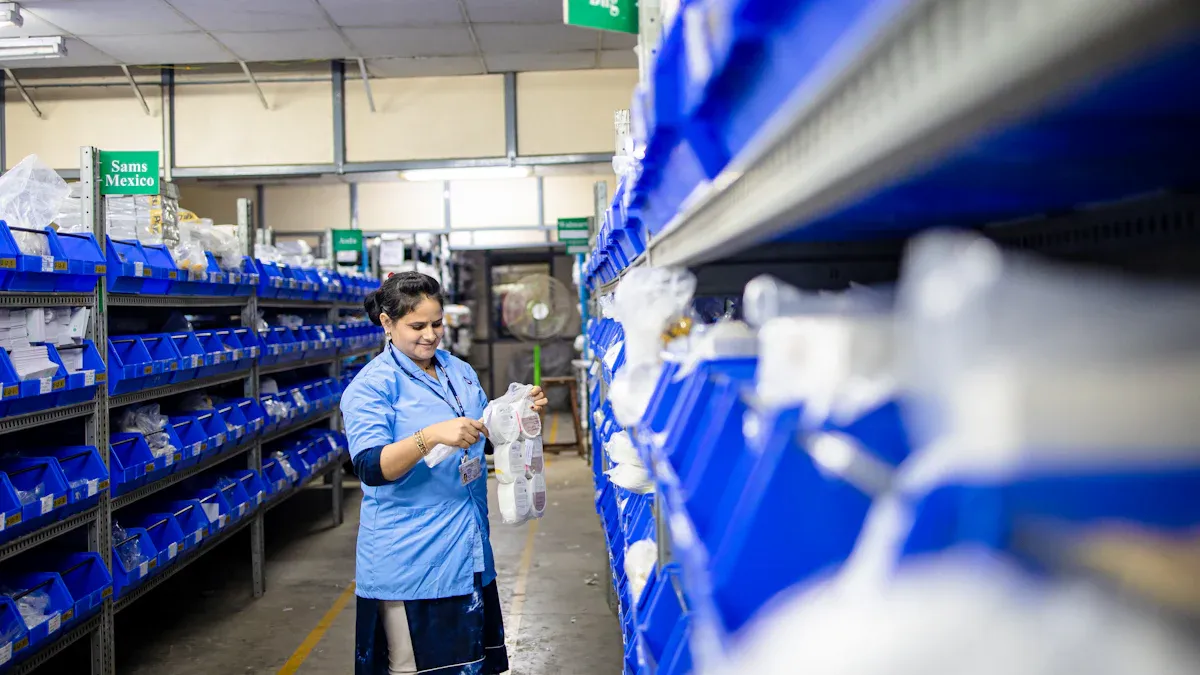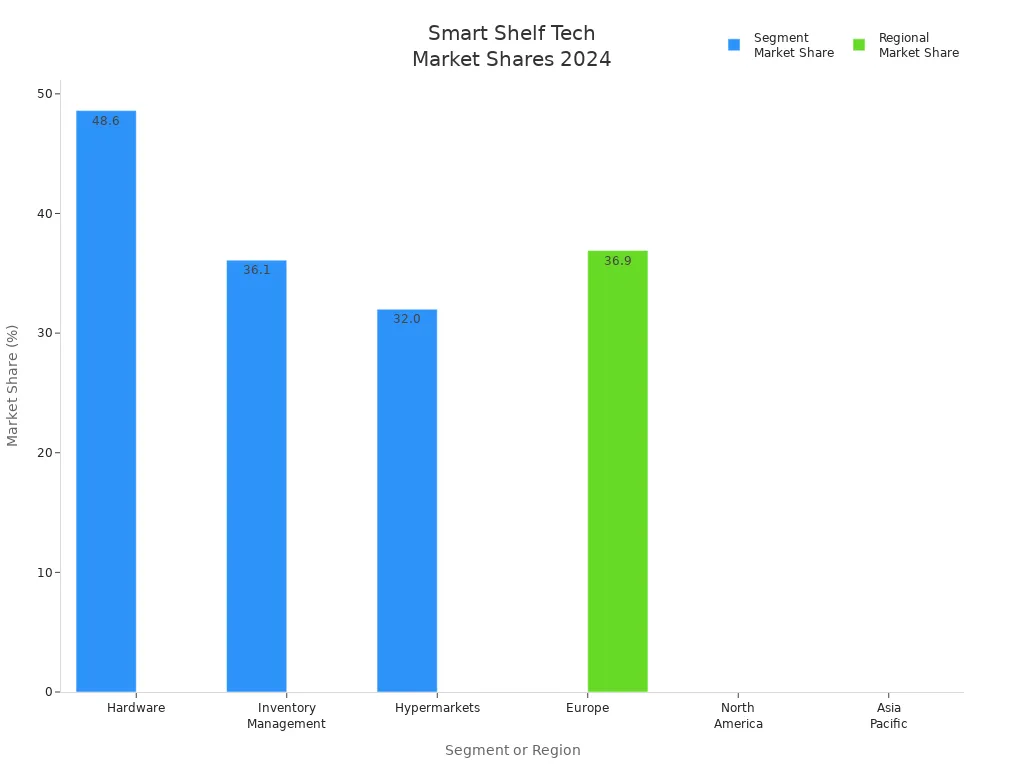
Walmart’s smart shelf technology uses IoT sensors, RFID tags, and Electronic Shelf Labels to automate inventory management and price updates. This system, powered by ESL Gateway AP and ESL Price Tag, enables Walmart to monitor stock levels in real time and optimize shelf operations. The technology outperforms traditional methods by reducing manual labor, improving accuracy, and speeding up replenishment. As Esl Retail expands globally, smart shelves drive efficiency and support the future of retail.


Walmart’s Transition to Digital Shelf Labels

What Are Digital Shelf Labels?
Core Features and Capabilities
Digital shelf labels have become a cornerstone of Walmart’s smart technology strategy. These labels replace traditional paper tags with electronic displays that show product information and price. The system consists of several main components:
- A central server manages product and price data.
- A gateway transmits updates wirelessly to shelf labels.
- Electronic shelf labels receive RF signals and display current price and product details.
Walmart’s digital shelf labels use wireless communication to update thousands of products in real time. The server processes pricing changes and sends them to the gateway, which then relays the information to each label. Each label has a unique identification code, allowing point-to-point and group communication. This integration with Walmart’s pricing system ensures accuracy and speed.
The technology supports multiple display types, including e-ink, LED, and LCD. E-ink displays offer high visibility and low power consumption, making them ideal for retail environments. The system’s design allows for customization, enabling Walmart to tailor digital solutions to specific store needs.
Note: Digital shelf labels improve operational efficiency and enhance the customer experience by providing accurate, up-to-date information.
E-Ink and Vusion Group Technology
Walmart leverages advanced e-ink technology for its digital shelf labels. E-ink displays mimic the appearance of ink on paper, providing clear visibility under various lighting conditions. These displays consume minimal energy, which supports Walmart’s sustainability goals.
Vusion Group supplies proprietary technology that enables seamless integration with Walmart’s existing systems. Their digital shelf labels offer robust wireless connectivity and support rapid price updates. The combination of e-ink and Vusion Group’s platform allows Walmart to manage over 120,000 products with thousands of weekly price changes.
| Feature | Benefit |
|---|---|
| E-ink display | Low energy use, high readability |
| Wireless RF updates | Real-time price and product information |
| Vusion Group platform | Customization and scalability |
| Unique ID codes | Accurate point-to-point communication |
Why Walmart Is Moving to Digital Shelf Labels
Pricing Accuracy and Efficiency
Walmart’s transition to digital shelf labels addresses several challenges in retail operations. Manual price updates often lead to errors, causing discrepancies and unplanned markdowns. Digital shelf labels automate price changes, reducing error rates from 3-5% to less than 0.1%. The system enables chain-wide price updates within minutes, eliminating costly mistakes and freeing staff for higher-value tasks.
Digital shelf labels allow Walmart to respond instantly to market conditions and competitor pricing. Real-time price adjustments ensure that promotions and discounts synchronize across all stores. Employees no longer spend hours changing paper tags, which increases productivity and allows them to focus on customer service and inventory management.
- Automated price updates eliminate human error.
- Real-time synchronization with promotions enhances customer trust.
- Labor savings allow staff to prioritize shelf replenishment and service.
Strategic Objectives
Walmart’s strategic objectives drive the transition to digital shelf labels. The company aims to improve operational efficiency, reduce manual labor, and support sustainability initiatives. Digital shelf labels eliminate paper waste and ongoing material expenses, aligning with Walmart’s environmental goals.
Features like “Stock to Light” and “Pick to Light” guide associates to exact shelf locations, speeding up stock replenishment and order picking. These digital solutions enhance accuracy for online orders and improve inventory management. Walmart positions itself as a leader in retail technology by adopting smart technology that meets evolving customer expectations.
- Faster price updates reduce a task from two days to minutes.
- Enhanced stock management improves order fulfillment.
- Sustainability goals benefit from reduced operational waste.
- Competitive advantage comes from early adoption of advanced technology.
Tip: Digital shelf labels provide long-term cost savings by lowering labor expenses, reducing pricing errors, and minimizing inventory shrinkage.
Implementation of Smart Shelf Technology in Walmart Stores
Rollout and Expansion Strategy
Pilot Programs and Initial Results
Walmart began its smart shelf journey by launching pilot programs in select stores. In Canada, Walmart tested AI-powered computer vision systems from Focal Systems in 70 locations. These systems used cameras and IoT sensors to monitor shelf stock levels and detect out-of-stock products in real time. Store teams received automated alerts, which improved operational efficiency and enhanced the customer experience. After the pilot’s success, Walmart expanded the technology nationwide, integrating it with existing inventory management platforms. This approach allowed associates to respond quickly to inventory issues and maintain optimal product availability.
In the United States, Walmart mapped manual shelf-stocking processes and introduced AI shelf-stocking systems across 4,600 stores. The company used predictive analytics to optimize replenishment and reduce manual restocking. Walmart’s strategy involved starting small, selecting scalable automation projects, and connecting systems for seamless data flow. This iterative process empowered store associates and improved overall efficiency.
Nationwide Deployment Timeline
Walmart’s nationwide deployment followed a structured timeline. The company first evaluated pilot results and identified best practices. Next, Walmart scaled the technology to additional stores, focusing on seamless integration with existing systems. The deployment included training for associates and upgrades to infrastructure, such as installing IoT sensors and RFID readers. Walmart prioritized stores with high inventory turnover and complex product assortments. The company completed the rollout in phases, ensuring each location received the necessary support and resources.
Walmart’s expansion strategy relied on continuous feedback and system improvements. The company monitored performance metrics, such as stock accuracy and replenishment speed, to guide further implementation. By leveraging AI and IoT, Walmart achieved rapid nationwide adoption of smart shelf technology.
Integration with Inventory Systems
Real-Time Stock Updates
Walmart’s integration with inventory systems centers on real-time stock updates. The company deploys AI-powered computer vision systems that use cameras and IoT sensors to monitor shelf conditions. These systems detect low or missing stock and automatically alert staff for replenishment. Walmart’s inventory management platforms receive data from smart shelf systems, enabling automated stock monitoring and improved on-shelf availability.
Retail Link, Walmart’s proprietary platform, plays a key role in this process. The platform aggregates data from smart shelf AI systems, RFID readers, and IoT devices. This integration allows Walmart to analyze inventory levels, automate ordering, and enhance supply chain transparency. Real-time data analytics support accurate stock management and reduce waste.
IoT and RFID Integration
Walmart extensively uses IoT and RFID technology to create a comprehensive inventory management ecosystem. IoT sensors track product movement and shelf conditions, while RFID tags enable real-time inventory tracking. RFID technology triggers automatic reorders when stock runs low, reducing manual labor and streamlining replenishment.
The integration with inventory systems ensures that data from RFID tags and IoT devices flows seamlessly into Walmart’s management platforms. This process enhances accuracy, supports automated decision-making, and improves customer satisfaction. Walmart’s use of RFID technology across its supply chain and stores sets a benchmark for operational efficiency.
| Technology | Function | Benefit |
|---|---|---|
| IoT sensors | Monitor shelf conditions | Real-time alerts |
| RFID tags | Track inventory movement | Automated reordering |
| AI systems | Analyze shelf stock | Improved accuracy |
| Retail Link | Aggregate data | Enhanced transparency |
Tip: Combining IoT and RFID technology with AI-powered systems enables Walmart to maintain high inventory accuracy and reduce out-of-stock incidents.
Employee Training and Change Management
Training Programs for Associates
Walmart invests in comprehensive training programs for store associates. The company provides hands-on instruction on using smart shelf technology, IoT devices, and RFID readers. Associates learn to interpret automated alerts, manage inventory data, and operate new systems efficiently. Training materials include step-by-step guides, video tutorials, and interactive workshops.
Walmart’s approach ensures that employees understand the benefits of smart shelf technology and feel confident using new tools. The company encourages ongoing learning and provides support through dedicated help desks and online resources.
Adapting Store Operations
Walmart adapts store operations to maximize the impact of smart shelf technology. Associates shift from manual price updates and inventory checks to managing automated systems. IoT sensors and RFID technology handle routine tasks, allowing employees to focus on customer service and strategic activities.
Store managers oversee the integration with inventory systems and monitor performance metrics. Walmart’s change management strategy includes regular feedback sessions and process reviews. The company fosters a culture of innovation, empowering associates to embrace new technology and drive continuous improvement.
Note: Effective training and change management ensure that Walmart’s smart shelf implementation delivers lasting benefits for both employees and customers.
Operational Benefits of Walmart’s Smart Shelf Implementation
Enhanced Efficiency and Productivity
Automated Price Updates
Walmart’s adoption of digital shelf labels has transformed price management across its stores. Associates no longer spend hours manually updating price tags. The digital system enables instant price changes, ensuring accuracy and consistency throughout the store network. Managers can synchronize price adjustments with promotions, reducing errors and improving operational efficiency. The automation of price updates supports higher productivity, allowing staff to focus on customer service and inventory tasks.
Streamlined Restocking
Digital shelf labels and RFID technology work together to optimize restocking. IoT sensors monitor shelf conditions and trigger alerts when stock runs low. Associates receive clear instructions for replenishment, guided by digital displays. RFID tags identify products quickly, speeding up the restocking process. Walmart reports that tagged products are replenished three times faster than those without RFID. This streamlined approach boosts productivity and maintains product availability for shoppers.
Improved Inventory Management
Out-of-Stock Prevention
Smart shelf technology has significantly reduced out-of-stock rates at Walmart. RFID-enabled stores experience 16% fewer out-of-stock items compared to locations without RFID. Real-time tracking allows associates to address inventory gaps immediately. The system’s effectiveness in replenishing stockouts reaches 63%, minimizing lost sales and enhancing customer satisfaction. Digital shelf labels provide instant visibility into product status, supporting proactive inventory management.
| Impact Area | Evidence Detail |
|---|---|
| Out-of-Stock Reduction | RFID-enabled stores had 16% fewer out-of-stock items compared to non-RFID stores. |
| Replenishment Speed | Tagged products were replenished 3 times faster than non-tagged products. |
| Stockout Replenishment Effectiveness | RFID stores were 63% more effective at replenishing stockouts, reducing lost sales. |
| Inventory Accuracy | Perpetual inventory accuracy improved to over 97% due to real-time tracking from receiving to shelf. |
| Operational Improvements | Manual store orders dropped by ~10% due to automated replenishment; lower excess inventory and carrying costs. |
| Strategic Shift | Transition from periodic manual counts to continuous automated inventory tracking, enabling omnichannel services like BOPIS. |
Data-Driven Decision Making
Walmart leverages digital shelf labels and RFID to collect data on inventory movement and shelf conditions. Managers analyze this data to optimize ordering and reduce excess stock. The transition from manual counts to automated tracking supports continuous improvement in supply chain efficiency. Real-time data empowers teams to make informed decisions, improving operational efficiency and reducing waste.
Cost Savings and Loss Prevention
Labor Cost Reduction
Automation of inventory tracking and replenishment processes has led to significant labor cost savings. Associates spend less time on manual checks and more time on value-added tasks. Digital shelf labels and RFID systems minimize the need for physical audits, lowering operational costs. Walmart reports a notable decrease in labor expenses due to these innovations.
Shrinkage Control
Smart shelf technology helps Walmart control shrinkage by maintaining optimal stock levels and preventing losses from stockouts. Automatic reorder triggers from digital shelf labels ensure popular products remain available. Improved inventory accuracy reduces overstocks and waste. Enhanced customer experience results from better product availability, supporting loss prevention efforts.
- Improved inventory accuracy through real-time updates from IoT sensors and AI analytics, reducing stockouts and overstocks.
- Automation of inventory tracking and replenishment processes led to labor cost reductions.
- Optimization of inventory levels minimized waste and reduced costs.
- Automatic reorder triggers from smart shelves helped maintain optimal stock levels, preventing losses due to stockouts.
- Enhanced customer experience by ensuring popular products remain in stock, indirectly supporting loss prevention.
- Walmart achieved a 30% reduction in out-of-stock items after adopting smart shelf technology.
- Significant labor cost savings were realized by automating manual inventory checks.
- Improved inventory accuracy reduced stockouts and overstocks, enhancing operational efficiency.
- The technology contributed to better customer satisfaction through improved product availability.
Tip: Walmart’s investment in digital shelf labels and RFID technology delivers measurable gains in operational efficiency, productivity, and cost control.
Impact on Walmart Employees and Customers

Employee Experience and Workflow Changes
New Skill Requirements
Walmart’s smart shelf technology has transformed the roles and responsibilities of store associates. Employees now interact with advanced systems, including AI-driven notifications and digital shelf labels. Walmart provides Virtual Reality (VR) training to help associates learn these new technologies in a safe and engaging environment. VR modules cover not only technical skills but also soft skills such as empathy and compliance. Associates must adapt to managing AI-powered alerts from the Intelligent Retail Lab, which uses real-time analytics to notify staff about stock levels. These changes require employees to develop new competencies, including interpreting digital data and maintaining visual standards on the sales floor. Walmart supports this transition by offering wage increases and opportunities for career growth.
- Associates use VR training to build confidence with new technology.
- Employees manage AI-driven notifications and digital shelf labels.
- Store roles now include maintaining visual standards and responding to real-time inventory alerts.
- Walmart encourages skill development with career advancement programs.
Reduced Manual Tasks
The introduction of smart shelf technology has reduced the number of repetitive tasks for Walmart associates. AI-powered inventory management systems automate routine processes, such as price updates and stock checks. The ‘vis pick’ QR code-based system helps employees quickly locate items, improving order fulfillment and product availability. Automation allows associates to focus on higher-value activities, such as assisting customers and maintaining store presentation. These workflow changes have modernized daily operations, increased productivity, and improved job satisfaction.
- Automation eliminates tedious manual tasks.
- Employees spend more time engaging with customers.
- Modernized workflows lead to higher productivity and satisfaction.
Note: By reducing manual labor, Walmart empowers associates to deliver a better customer experience and support the company’s omnichannel experience goals.
Customer Experience Enhancements
Price Accuracy and Transparency
Smart shelf technology delivers significant improvements in price accuracy and transparency for Walmart customers. Digital shelf labels update prices instantly, ensuring that customers always see the latest promotions and discounts. The integration of shelf prices with checkout systems reduces errors and disputes, building trust and confidence in the shopping experience. High-contrast screens and clear fonts make price information easy to read, supporting informed purchasing decisions.
Product Availability and Shopping Convenience
Walmart’s digital shelf labels and AI-driven systems enhance product availability and overall shopping convenience. LED lights on shelf labels assist employees with stocking and order picking, leading to faster restocking and improved service. Customers benefit from immediate access to new deals and promotions, as Walmart can launch price changes across thousands of items in seconds. These features contribute to a seamless customer experience and support Walmart’s commitment to an efficient omnichannel experience.
| Feature/Benefit | Description | Impact on Walmart Customers |
|---|---|---|
| Real-time Price Updates | Digital shelf labels update prices instantly. | Customers see the latest prices and promotions, improving accuracy. |
| LED Assistance for Employees | LED lights guide employees during stocking and picking. | Faster restocking and better product availability. |
| Faster Promotional Changes | Promotions launch across thousands of items in seconds. | Immediate access to deals and flash sales. |
| Readability and Accessibility | High-contrast screens and clear fonts. | Easy-to-read price information for all shoppers. |
| Integration with POS Systems | Shelf prices synchronize with checkout systems. | Reduces errors and builds customer trust. |
| Operational Efficiency | Associates spend less time on manual updates. | More time for customer assistance and improved shopping experience. |
Tip: Walmart’s investment in smart shelf technology ensures that customers enjoy a transparent, accurate, and convenient shopping experience every time they visit the store.
Sustainability and Environmental Impact of Digital Shelf Labels
Waste Reduction and Resource Efficiency
Eliminating Paper Labels
Walmart’s adoption of digital shelf labels marks a significant step toward reducing waste in retail operations. Traditional paper price tags require frequent replacements, leading to high material usage and landfill waste. Digital shelf labels, by contrast, use durable materials and e-ink technology, which last for years and can be recycled or refurbished at the end of their lifespan. This shift minimizes the need for wood pulp, ink, adhesives, and plastic holders.
| Aspect | Paper Price Tags | Digital Shelf Labels |
|---|---|---|
| Material Usage | Wood pulp, ink, adhesives, plastic holders | Durable, reusable materials, e-ink technology |
| Waste Generation | High, frequent replacements, landfill waste | Minimal, long lifespan, reusable components |
| Carbon Emissions | High from production and disposal | Drastically reduced, fewer replacements |
| Lifespan | Single-use, short-lived | 3-10 years, long-lasting |
| Recycling & Reuse | Limited, most tags not recycled | Components can be refurbished or recycled |
Digital shelf labels enable centralized, real-time updates, eliminating the need for manual replacement of paper tags. This approach reduces labor, errors, and the waste associated with frequent printing and disposal. Walmart estimates that switching to electronic shelf labels will save approximately 300,000 pounds of paper annually, directly supporting its sustainability initiatives.
Efficient Stock Rotation
Digital shelf labels also improve resource efficiency by enabling real-time inventory management. The system allows Walmart to update prices and product information instantly, which helps optimize stock rotation and markdowns. By reducing unsold and expired inventory, digital shelf labels lower environmental harm and support a more sustainable retail model. Employees can focus on higher-value activities, further enhancing operational efficiency.
Energy Efficiency and Smart Integration
Smart Rails and Energy-Saving Features
Digital shelf labels use e-paper technology, which consumes power only during updates. When the display remains static, energy use drops to nearly zero. Batteries in these digital labels can last between five and ten years, reducing both energy consumption and waste. Innovations such as Bluetooth Low Energy communication and smart rails further decrease power requirements. Some digital labels even incorporate solar or kinetic energy features, pushing energy efficiency to new levels.
- Digital shelf labels consume almost no power when static.
- Batteries last up to a decade, minimizing replacements.
- Bluetooth Low Energy and smart rails optimize energy use.
- Solar-powered options enhance sustainability.
Note: Real-world case studies show that digital pricing systems can save up to 40% more energy over five years compared to traditional paper labeling.
Supporting Walmart’s Sustainability Goals
Walmart’s commitment to sustainability extends beyond waste reduction. By implementing digital shelf labels, the company aligns its operations with broader environmental goals. The reduction in paper usage and operational waste positions Walmart as a leader in retail sustainability. Digital shelf labels also help reduce food waste by enabling precise stock rotation and timely markdowns. This digitization supports Walmart’s efforts to minimize its environmental footprint and improve resource management across all stores.
Challenges and Considerations in Walmart’s Implementation
Upfront and Ongoing Costs
Investment in Technology
Walmart’s transition to smart shelf technology requires significant capital investment. The company allocates funds for electronic shelf labels, IoT sensors, RFID tags, and supporting infrastructure. Initial costs include hardware procurement, software licensing, and network upgrades. Walmart must also invest in integration with existing inventory systems. These expenses represent a substantial commitment, especially for large-scale deployment across thousands of stores.
| Cost Category | Description |
|---|---|
| Hardware | Shelf labels, sensors, RFID tags |
| Software | Licensing, system integration |
| Infrastructure | Network upgrades, gateways |
| Training | Employee education and onboarding |
Maintenance and Upgrades
Ongoing costs present another challenge for Walmart. The company schedules regular maintenance for digital shelf labels and IoT devices. Batteries require periodic replacement, and software updates must address security vulnerabilities and performance improvements. Walmart evaluates the need for upgrades as technology evolves. These recurring expenses impact long-term budgeting and resource allocation.
Note: Proactive maintenance and timely upgrades help Walmart maximize the lifespan and reliability of smart shelf systems.
Security, Privacy, and Data Protection
Safeguarding Customer Data
Walmart’s smart shelf technology introduces new considerations for data protection. The system can collect in-store data on customer interactions with locked products. Retail analysts highlight the importance of balancing convenience with privacy. Walmart tests features that allow employees and Walmart+ members to unlock cases using their phones. This approach aims to reduce theft and improve the shopping experience. However, experts warn that the technology could expose customer data to risks if not properly managed.
- The system may gather data on how customers interact with products.
- Walmart+ members use mobile devices to unlock cases, raising privacy questions.
- The company must ensure that customer information remains secure.
System Security Measures
Security remains a top priority for Walmart. The company faces challenges in preventing misuse of smart shelf systems. Experts note that dishonest actors could attempt to bypass security using burner phones or fake IDs. Retailers must implement safeguards to protect against unauthorized access. Walmart continues to test the technology, evaluating its effectiveness in loss prevention. The company considers the needs of less tech-savvy customers, who may avoid using mobile apps. Balancing convenience, security, and inclusivity requires ongoing attention.
Tip: Retailers must regularly assess system vulnerabilities and update security protocols to address emerging threats.
Employee Adoption and Training
Overcoming Resistance
Walmart recognizes that employee adoption plays a critical role in successful implementation. Associates may resist new technology due to unfamiliarity or concerns about job changes. The company addresses resistance by providing clear communication and demonstrating the benefits of smart shelf systems. Managers encourage feedback and foster a culture of innovation.
Continuous Learning Initiatives
Ongoing training supports employee adaptation. Walmart offers workshops, online resources, and hands-on instruction. Associates learn to operate digital shelf labels, interpret alerts, and maintain system integrity. Continuous learning initiatives ensure that employees stay current with technological advancements and operational best practices.
- Regular training sessions build confidence and competence.
- Support resources help associates troubleshoot issues.
- Walmart invests in employee development to sustain long-term success.
Callout: Effective training and open communication empower Walmart associates to embrace smart shelf technology and drive operational excellence.
Future Implications of Smart Shelf Integration for Walmart and Retail
Scaling and Industry Adoption
Expansion Plans and Timelines
Walmart continues to expand its smart shelf technology, planning to implement electronic shelf labels in 2,300 stores by 2026. This large-scale rollout leverages IoT, cloud, and AI to enhance store digitalization. Employees benefit from reduced manual tasks, improved pricing agility, and faster online order fulfillment. As Walmart deploys Vusion digital shelf labels across all 4,600 US stores, the company sets a benchmark for operational efficiency and digital transformation in retail. The scale of this expansion signals a shift in the future of retail, encouraging other grocers to accelerate their own adoption of digital shelf labeling.
Influence on Retail Competitors
Walmart’s RFID mandate and smart shelf integration have influenced major retailers such as Nordstrom and Lululemon to adopt similar technologies. These changes drive industry-wide improvements in inventory accuracy and operational efficiency. Collaborative efforts, including GS1 guidelines, ensure interoperability and best practices across retailers and suppliers. The table below highlights how leading retailers respond to Walmart’s innovation:
| Retailer | Digital Transformation Strategy | Relation to Walmart’s Smart Shelf Technology |
|---|---|---|
| Walmart | IoT sensors, computer vision for real-time inventory tracking | Baseline innovation prompting others’ responses |
| Amazon | Just Walk Out tech for frictionless checkout | Analogous use of real-time tracking and automation |
| Walgreens | Edge computing for real-time offers and shelf monitoring | Similar use of edge computing and inventory management |
| H&M | AI-driven forecasting and automated reordering | Complementary automation for inventory optimization |
| Target | Cloud migration for scalable infrastructure | Supports digital operations scalability |
| Nike, Starbucks, Shopify | AI personalization, loyalty tech, headless commerce | Broader digital transformation aligned with retail modernization |
Other retailers now embrace real-time inventory management, automation, and in-store data analytics, reflecting a broader trend toward advanced digital tools in retail.
Innovations in Smart Shelf Technology
AI and Predictive Analytics
Walmart leverages AI-powered cameras and predictive analytics to monitor shelf inventory and forecast product demand. These technologies enable real-time data analytics, helping Walmart optimize inventory levels and reduce waste. Store advisors powered by AI provide recommendations on pricing, returns, and donations, supporting sustainability goals and minimizing unsold items. By digitizing physical stores, Walmart enhances collaboration with suppliers and improves supply chain transparency. In-store data analytics drive better demand forecasting and inventory adjustments, shaping the future of retail operations.
Augmented Reality and Future Tools
Augmented reality (AR) is transforming retail from novelty to necessity. AR devices, such as smart glasses and headsets, allow users to access product information, styling tips, and inventory data hands-free. Customers can virtually try on products and visualize items in their own space, reducing return rates and increasing engagement. AR navigation systems help shoppers find products easily, while employee-facing AR tools improve inventory accuracy and highlight product gaps. The AR-in-retail market is projected to grow rapidly, driving immersive shopping experiences and operational efficiency. Future tools like spatial computing and AI assistants will further enhance personalized customer service and inventory management.
- AR enhances customer engagement and drives sales through virtual try-ons and in-store activations.
- Smart glasses overlay digital information, transforming physical shopping and supporting employee roles.
- Integration with RFID and sensors enables real-time inventory tracking and personalized shopping experiences.
Shaping the Future of Retail Operations
Evolving Customer Expectations
Smart shelf integration elevates customer expectations for convenience, autonomy, and information access. Electronic shelf labels improve psychological well-being by providing clear product information and interactive features. Customers experience greater happiness, agency, and willingness to pay premium prices. Retailers create autonomous, efficient shopping environments that empower consumers and streamline purchase processes. These changes reinforce competitive advantages and shift traditional retail dynamics.
The Role of Integration with Inventory Systems
Smart shelf technology uses IoT devices, smart scales, and RFID tags to detect stock removal and trigger replenishment. Cameras personalize the shopping experience and provide real-time inventory visibility. Integration with inventory systems aligns stock levels with demand, improving vertical integration and reducing overproduction. Cloud-based infrastructure supports scalability and diverse retail formats. Real-time inventory tracking and automated replenishment minimize stockouts and overstock, supporting dynamic pricing and omnichannel retail strategies. Retailers transition from traditional models to agile, data-driven ecosystems, driving operational efficiency and growth.
Tip: Retailers that embrace smart shelf integration and advanced analytics position themselves at the forefront of the future of retail, delivering superior customer experiences and operational excellence.
Walmart’s smart shelf technology redefines retail efficiency and customer experience. The transition to digital shelf labels delivers operational, financial, and sustainability benefits. Automation and real-time data drive productivity and accuracy, while RFID and robotics set new standards for inventory management. The global smart shelf market reflects rapid growth and innovation, as shown below:
| Key Aspect | Details |
|---|---|
| Market Size (2024) | USD 3.5 Billion |
| Projected Market Size (2034) | USD 31.3 Billion (CAGR 24.5%) |
| Leading Application | Inventory Management (36.1%) |
| Regional Leader | Europe (36.9% share), North America follows |

Smart shelf integration signals a transformative future for Walmart and the global retail industry.
FAQ
What is Walmart’s smart shelf technology?
Walmart’s smart shelf technology uses electronic shelf labels, IoT sensors, and RFID tags. These tools automate price updates and inventory tracking. The system improves accuracy, reduces manual labor, and supports real-time stock management.
How do digital shelf labels benefit Walmart stores?
Digital shelf labels allow instant price changes and reduce pricing errors. Employees spend less time on manual updates. The technology supports faster restocking and improves the overall shopping experience for customers.
Are digital shelf labels environmentally friendly?
Yes. Digital shelf labels eliminate the need for paper tags. E-ink displays use minimal energy and last for years. This approach reduces waste and supports Walmart’s sustainability goals.
What challenges does Walmart face with smart shelf technology?
Walmart faces high upfront costs for hardware and integration. Ongoing maintenance and employee training require continuous investment. Security and data protection remain important concerns.
How does smart shelf technology affect Walmart employees?
Employees learn new skills to manage digital systems and interpret real-time alerts. Automation reduces repetitive tasks. Associates focus more on customer service and store presentation.
Will other retailers adopt similar technology?
Many retailers already explore smart shelf solutions. Walmart’s large-scale adoption sets a benchmark. Industry trends suggest more companies will implement digital shelf labels and IoT-based inventory management.
How does smart shelf technology improve the customer experience?
Customers see accurate prices and up-to-date promotions. Product availability improves due to faster restocking. The technology creates a more convenient and transparent shopping environment.
Tip: Smart shelf technology helps retailers stay competitive by improving efficiency, accuracy, and sustainability.


